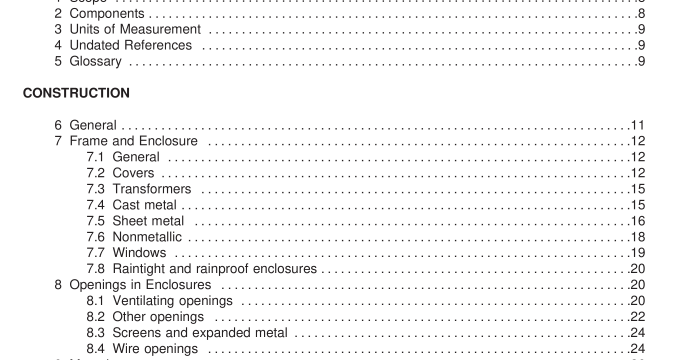UL 916-2015 pdf download.Energy Management Equipment.
5.7 ISOLATED LIMITED-ENERGY SECONDARY CIRCUIT – A circuit derived from an isolated secondary winding of a transformer having a maximum capacity of 1 00 volt-amperes and an open-circuit secondary-voltage rating not exceeding 1 000 volts. 5.8 ISOLATION – Electrical separation between two locations. 5.9 JUNCTION TEMPERATURE – A theoretical temperature based on a simplified representation of the thermal and electrical behavior of a semiconductor device. 5.1 0 MAXIMUM CASE TEMPERATURE – A specification, usually in the form of a curve of on-state current versus maximum case temperature, that refers to the maximum case temperature of a thyristor with regard to the on-state current. The case is an external point on the thyristor where this temperature is related to the maximum junction temperature for the thyristor. 5.1 1 NONISOLATED LIMITED-ENERGY LOW-VOLTAGE CIRCUIT (POWER SOURCE) – A circuit derived from a source of supply classified as line-voltage by connecting impedance in series with the supply circuit as a means of limiting the voltage and power to comply with Class 2 characteristics. 5.1 2 OPPOSITE POLARITY – A difference of potential between two points, where shorting of these two points would result in a condition involving overload, rupturing of printed wiring board tracks, components or fuses, and the like. 5.1 3 OPTICAL ISOLATOR – A photon-coupled device consisting of a light source and sensor integrated into a single package that provides circuit isolation. 5.1 4 PILOT DUTY RATING – A rating applied to electromagnetic loads. 5.1 5 PORTABLE EQUIPMENT – Cord- and plug-connected equipment that is capable of being carried or moved about. 5.1 6 PRIMARY CIRCUIT – The wiring and components that are conductively connected to the supply circuit.
6 General 6.1 An electronic or solid-state circuit used in a back-up, limiting, or other safety control, including controls that require a calibration test, is evaluated on the basis of its compliance with the requirements in this standard. Electronic components shall comply with the requirements for the application. 6.2 A circuit extending from the equipment and intended for connection to a low-voltage Class 2 circuit as defined in the National Electrical Code, ANSI/NFPA 70, shall not involve a potential of more than 30 volts rms (42.4 volts peak) and be supplied by: a) A primary battery; b) A standard Class 2 transformer; or c) A combination of a transformer and a fixed impedance that, as a unit, complies with all the performance requirements for a Class 2 transformer. 6.3 A circuit derived from a line-voltage circuit by connecting resistance in series with the supply circuit as a means of limiting the voltage and current is considered to be a low-voltage circuit when the impedance has been investigated for such use. See Isolating Resistor Evaluation, Section 67. 6.4 The equipment shall use materials that comply with the requirements for the application and shall be made and finished with the degree of uniformity and grade of workmanship practicable in a well-equipped factory.
7 Frame and Enclosure 7.1 General 7.1 .1 Equipment shall be formed and assembled so that it will have the strength and rigidity necessary to resist the abuses to which it may be subjected, without increasing the risk of fire, electric shock, or injury to persons due to total or partial collapse resulting in a reduction of spacings, loosening or displacement of parts, or other serious defects. 7.1 .2 Equipment that complies with the requirements in 7.1 .3 – 7.8.6 is considered to comply with 7.1 .1 . 7.1 .3 Electrical parts of the equipment, other than a supply cord or low-voltage terminals, shall be located or enclosed so that the risk of unintentional contact with uninsulated live parts will be reduced. Exception: An enclosure is not required for equipment intended for field installation within the enclosure of another product provided that: a) All required markings are provided as specified in Sections 72 – 75 and b) The temperature, overvoltage and undervoltage tests are conducted with the equipment in a 40 ± 2°C (1 04 ± 3.6°F) ambient. See Barriers, Section 37, and the Overvoltage and Undervoltage Tests, Section 43. 7.1 .4 Equipment incorporating an air-filtering system or utilizing a tight-fitting enclosure may be subject to an investigation to determine whether it provides the equivalent of a controlled environment. Exception: A gasketed enclosure is considered to provide an enclosed environment. 7.1 .5 An air filter acting as an enclosure part shall comply with the requirements for Class 1 filters as specified in the Standard for Air Filter Units, UL 900. If abnormal tests show that an equivalent flame barrier exists, then an air filter is not considered to be an enclosure part and may be omitted.UL 916-2015 pdf download.
UL 916-2015 pdf download
